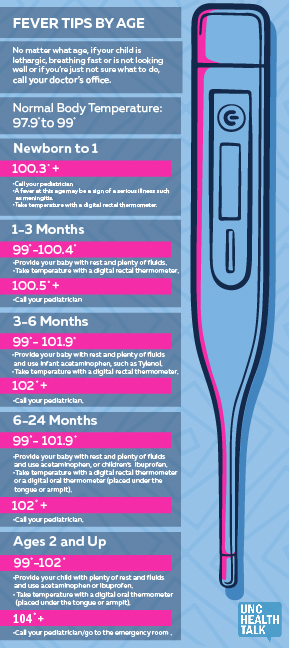Just like sprouting that first tooth, scraping a knee while learning to walk and going to kindergarten, every child will eventually experience a fever. Still, it can be a scary experience, especially for first-time parents.
While you should take a child’s fever seriously, you don’t need to panic. We talked to Ty G. Bristol, MD, MPH, pediatrician at UNC Pediatrics at Panther Creek, about what’s important for parents to know and do when their little one has a fever.
Normal Body Temperature
Body temperature is a measure of your body’s ability to generate and dispose of heat. You may have heard that the normal body temperature is 98.6 degrees, but this number is only an average. Everyone’s body temperature varies and can differ by age or activity level. The average body temperature for babies and children ranges from 97.9 degrees to 99 degrees, while the average body temperature for adults ranges from 97 degrees to 99 degrees.
Nature’s Alarm System
A fever means a body temperature that’s higher than normal. Most of the time an elevated temperature means your child’s immune system is doing its job fighting an infection.
“It’s your friend, because it’s telling you something is wrong, and we hope whatever’s wrong is not something too serious,” Dr. Bristol says.
While most fevers in children are from viral infections, Dr. Bristol says some rheumatic conditions, such as types of juvenile arthritis, and inflammatory bowel disease, such as Crohn’s disease or ulcerative colitis, also can cause a fever.
Know Your Numbers
If you suspect your child has a fever, take her temperature. What is considered a medically significant fever depends on age, Dr. Bristol says. For a 1-month-old, it’s 100.3 to 100.4 degrees or higher. It rises to 100.5 and above in children more than a month old.
“Parents should have a really good thermometer at home, one you can use either under the tongue or the armpit or a rectal thermometer,” Dr. Bristol says. “These are easier to read than ear or skin thermometers.”
He recommends using a rectal thermometer for babies and young children because it’s most accurate.
“It is important to have an accurate temperature for young babies because we’re going to have to make very big medical decisions for the baby, and we want to make sure we have the most accurate temperature before we do,” Dr. Bristol says.
Young infants are susceptible to several dangerous conditions because they have not received all their vaccines. Pediatricians have to assume the baby’s fever could be caused by a serious bacterial infection, meningitis, a urine infection, a blood infection or pneumonia.
“So for a younger baby, we have to do a spinal tap to rule out meningitis,” he says. “And we have to rule out the flu. This is why everyone around babies and children should be up to date on their vaccines, get a flu vaccine and wash their hands. Keep your baby away from big crowds as well.”
Signs of Fever
Children with fevers usually breathe faster, have an elevated heart rate and experience cold sweats. They also may be lethargic.
“If your baby’s breathing fast or you’re holding them and you feel their heart pounding or they’re sweating, take a temperature, because that might be the first sign that they actually have a fever,” Dr. Bristol says.
Treating a Fever
Because a fever usually signals that your child has an infection, you can’t treat the infection itself, but you can use a fever reducer to help your child feel better. Give children younger than 6 months an infant acetaminophen, such as Tylenol. Older babies and children can take children’s ibuprofen, such as Motrin or Advil. Ask your doctor about the right dose for your child. Do not give children under 16 aspirin because it can cause Reye’s syndrome, a potentially fatal liver condition.
While some parents alternate doses of acetaminophen and ibuprofen, Dr. Bristol does not recommend it.
“It has never really been shown to actually be more effective than just one medicine,” he says. “And folks lose track of what they gave when, so there’s a higher risk for overdose if you’re using two medicines.”
A sponge bath is one of the quickest ways to bring down a fever, Dr. Bristol adds.
“Take a cloth, add room temperature water from the tap and just wipe the baby down. And that will bring the fever down even faster than the Motrin or the Tylenol,” he says.
A Note About Seizures
Some kids who have a rapid rise in temperature will experience a febrile seizure. Febrile seizures occur in 2 to 5 percent of American children before age 5.
“For those kids, the seizure doesn’t come on when the fever is 104. It comes on when the fever went from 99.6 to 102. It happens because there is a rapid change in the temperature,” Dr. Bristol says. “Only a subset of children who get fevers experience seizures. Thankfully most of those kids don’t go on to have epilepsy or chronic seizures.”
When to Call the Doctor
When a fever has gone down, your child should be smiling, running around and drinking fluids. If the fever is down and your child is still lethargic, breathing fast or not looking well, call your doctor.
“The height of the fever doesn’t always tell you how bad something is. It’s also how the child looks,” Dr. Bristol says. “You can have a 101 fever and have something terrible going on, and you can have a 104 fever and it’s just a mild virus.”
For example, babies sometimes get a viral infection called roseola, which causes a fever as high as 104 for three to five days and a rash.
“There’s no medicine for it, and it eventually goes away and doesn’t cause any problems. But then you can have a young baby with a 101 fever who has meningitis, a urine infection, pneumonia or bacteria in their blood, and that’s a serious condition,” Dr. Bristol says. “So how the child looks is important.”
No matter what, if your baby is younger than 3 months old with a fever of 100.5 or higher, call your doctor. And Dr. Bristol says when in doubt, call your doctor’s office.
“Call us, speak to the nurses or your doctor,” he says, “because there are always nuances and other things that we might know that can help.”

If you are concerned about your child’s fever, call your child’s primary care provider. If you don’t have one, find a doctor near you.

